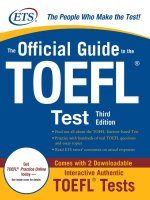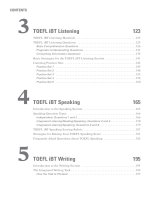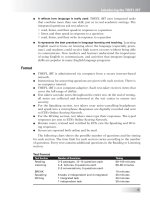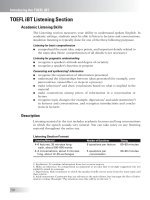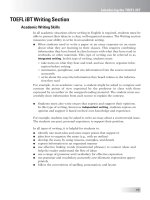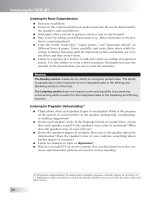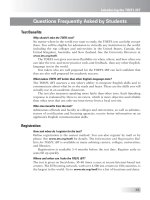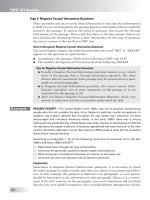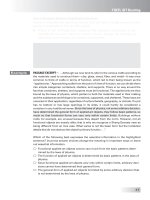The official guide to the toefl ibt third edition part 3 ppt
Bạn đang xem bản rút gọn của tài liệu. Xem và tải ngay bản đầy đủ của tài liệu tại đây (467.81 KB, 7 trang )
5
b
It reflects how language is really used. TOEFL iBT uses integrated tasks
that combine more than one skill, just as in real academic settings. The
integrated questions ask test takers to
t
read, listen, and then speak in response to a question
t
listen and then speak in response to a question
t
read, listen, and then write in response to a question
b
It represents the best practices in language learning and teaching. Learning
English used to focus on learning about the language (especially gram-
mar), and students could receive high scores on tests without being able
to communicate. Now teachers and learners understand the importance
of using English to communicate, and activities that integrate language
skills are popular in many English language programs.
Format
b
TOEFL iBT is administered via computer from a secure internet-based
network.
b
Instructions for answering questions are given with each section. There is
no computer tutorial.
b
TOEFL iBT is not computer-adaptive. Each test-taker receives items that
cover the full range of ability.
b
Test takers can take notes throughout the entire test. At the end of testing,
all notes are collected and destroyed at the test center to ensure test
security.
b
For the Speaking section, test takers wear noise-cancelling headphones
and speak into a microphone. Responses are digitally recorded and sent
to ETS’s Online Scoring Network.
b
For the Writing section, test takers must type their responses. The typed
responses are sent to ETS’s Online Scoring Network.
b
Human raters, trained and certified by ETS, rate the Speaking and Writ-
ing responses.
b
Scores are reported both online and by mail.
The following chart shows the possible number of questions and the timing
for each section. The time limit for each section varies according to the number
of questions. Every test contains additional questions in the Reading or Listening
section.
Test Format
Test Section Number of Questions Timing
Reading 3–5 passages, 12–14 questions each 60–100 minutes
Listening 4–6 lectures, 6 questions each 60–90 minutes
2–3 conversations, 5 questions each
BREAK 10 minutes
Speaking 6 tasks: 2 independent and 4 integrated 20 minutes
Writing 1 integrated task 20 minutes
1 independent task 30 minutes
Introducing the TOEFL iBT
Introducing the TOEFL iBT
6
Tool Bar
The on-screen tool bar in each section allows you to navigate through the test
with ease. Following are examples of testing tools from the Listening and Read-
ing sections of the test. The section is always listed in the upper left-hand corner
of the tool bar.
This is what the tool bar looks like in the Listening section.
b
You will always know what question you are on and how much time is
remaining in the section. It is possible to hide the clock at any time by
clicking on
Hide Time.
b
Volume allows you to adjust the volume of the Listening passages.
b
Help allows you to get relevant help. When you use the Help feature, the
clock does not stop.
b
Next allows you to proceed to the next question.
b
Once you click on Next, you can confirm your answers by clicking on OK.
In the Listening section, you cannot see a question again once you click
on
OK.
The tool bar for the Reading section has some important features.
You can view the entire passage when answering questions. For some ques-
tions, you need to click on
View Text to see the entire passage.
You can view all your answers by clicking on
Review. This allows you to
return to any other question and change your answer. You can also see which
questions you have skipped and still need to answer.
In the Reading section you can also click on
Back at any time to return to the
previous question.
7
TOEFL iBT Reading Section
Academic Reading Skills
The Reading section measures your ability to understand university-level aca-
demic texts and passages. In many academic settings around the world, students
are expected to read and understand information from textbooks and other
academic materials written in English. The following are three purposes for aca-
demic reading:
Reading to find information
b
effectively scanning text for key facts and important information
b
increasing reading fluency and rate
Basic comprehension
b
understanding the general topic or main idea, major points, important
facts and details, vocabulary in context, and pronoun references
1
b
making inferences
2
about what is implied in a passage
Reading to learn
b
recognizing the organization and purpose of a passage
b
understanding relationships between ideas
b
organizing information into a category chart or a summary in order to
recall major points and important details
b
inferring how ideas throughout the passage connect
Description
Reading Section Format
Length of Each Passage Number of Passages and Questions Timing
Approximately 700 words 3–5 passages 60 –100 minutes
12–14 questions per passage
Reading Passages
The TOEFL iBT uses reading passages from university-level textbooks that intro-
duce a discipline or topic. The excerpts are changed as little as possible so the
TOEFL iBT can measure how well students can read academic material.
The passages cover a variety of different subjects. You should not be con-
cerned if you are unfamiliar with a topic. The passage contains all the informa-
tion needed to answer the questions.
Introducing the TOEFL iBT
1. Pronoun references: The nouns that pronouns refer to in a passage
2. Make an inference: To comprehend an argument or an idea that is strongly suggested, but not
explicitly stated in a passage
Introducing the TOEFL iBT
All passages are classified into three basic categories:
b
exposition
3
b
argumentation
4
b
historical
Often, passages present information about the topic from more than one per-
spective or point of view. This is something you should note as you read. Usually,
you are asked at least one question that allows you to demonstrate that you
understood the general organization of the passage. Common organization types
that you should be able to recognize are:
b
classification
b
compare/contrast
b
cause/effect
b
problem/solution
You must read through or scroll to the end of each passage before receiving
questions on that passage. Once the questions appear, the passage appears on the
right side of the computer screen. The questions are on the left. (See the illustra-
tion that follows.)
8
3. Exposition: Material that provides an explanation of a topic
4. Argumentation: Material that presents a point of view about a topic and provides evidence to
support it
9
Introducing the TOEFL iBT
You do not need any special background knowledge to answer the questions
in the Reading section correctly, but the definition of difficult words or phrases in
the passage may be provided. If you click on the word, a definition appears in the
lower left part of the screen.
The 60 to 100 minutes allotted for this section include time for reading the
passages and answering the questions.
Reading Question Formats
There are three question formats in the Reading section:
b
questions with four choices and a single answer in traditional multiple-
choice format
b
questions with four choices and a single answer that ask test takers to
“insert a sentence” where it fits best in a passage
b
“reading to learn” questions with more than four choices and more than
one possible correct answer.
Features
Reading to learn questions
These questions test your ability to recognize how the passage is organized and
understand the relationships among facts and ideas in different parts of the
passage.
You are asked to sort information and place the text options provided into
a
category chart or summary (see the examples on page 11). The summary ques-
tions are worth up to 2 points each. The chart questions are worth up to 3 points
if there are five options presented, and up to 4 points if there are seven options
presented. Partial credit is given in this question format.
Introducing the TOEFL iBT
10
Paraphrase questions
Questions in this category are in multiple-choice format. They test your ability to
select the answer choice that most accurately paraphrases a sentence from the
passage.
Glossary feature
You can click on some special purpose words and phrases in the reading passages
to view a definition or explanation of the term. In the example below, test takers
can click on the word “shamans” to view its definition.
11
Introducing the TOEFL iBT
Reading to Learn—Summary Question Example
Reading to Learn—Category Chart Question Example

